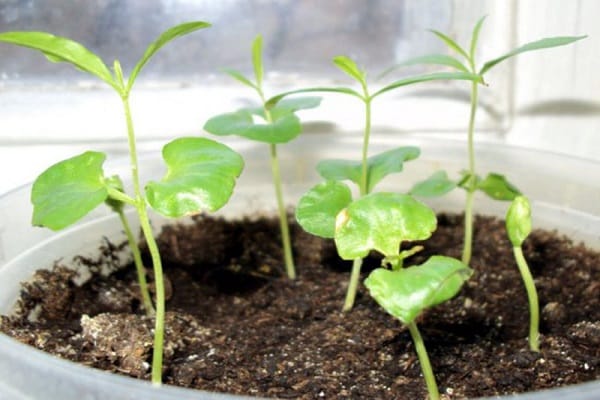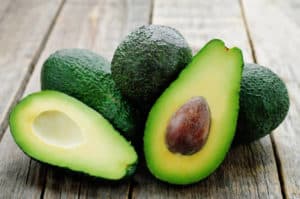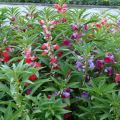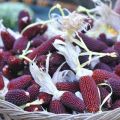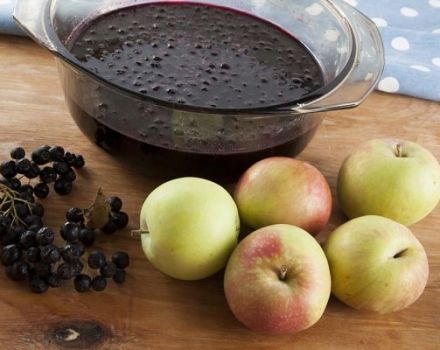Rules for planting and caring for indoor pomegranate and methods of growing at home
To decorate the interior, many grow indoor plants. It can be flowers or just green bushes, climbing vines. Pomegranate, as a houseplant, is quite rare. Although it grows well at home. You can grow an ornamental shrub or tree. With the right care of the dwarf species, you can enjoy delicious, juicy fruits.
Content
- 1 What varieties of pomegranate are grown at home
- 2 External parameters and characteristics
- 3 Growing and propagating a house tree
- 4 How pomegranate grows
- 5 Necessary conditions for growth
- 6 Care rules
- 7 How to plant a pomegranate for fruiting
- 8 The beginning of flowering and fruiting and features of care during this period
- 9 Diseases and characteristic symptoms
- 10 What problems arise when growing
What varieties of pomegranate are grown at home
The best dwarf varieties are Carthage and Baby. They are the most decorative. They are bred not so much for the sake of fruit, but because of abundant flowering. The shrub is strewn with small, but very beautiful, numerous scarlet flowers from spring to autumn.
For beginner growers, it is better to purchase a plant in a pot. No need to wait for seedlings until it grows. The finished bush will bloom faster. But if you want to see the whole process - from sowing to fruiting, then you should start by buying seeds.
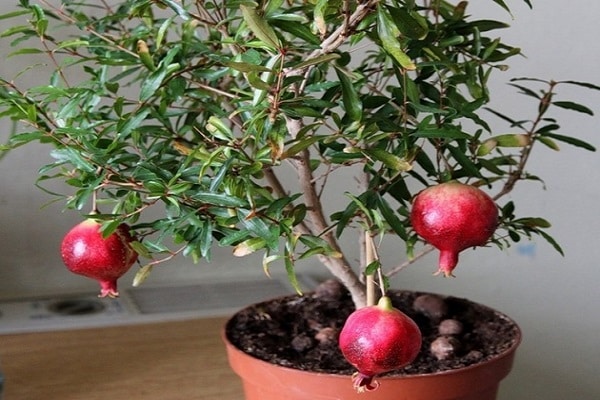
Carthage
Variety Carthage - a tree less than a meter tall with small leaves. Requires a haircut, without which the branches become thinner, the plant blooms less often. The fruits are small, the size of a matchbox. Edible, sweet and sour taste. Seed germination is low.
From the moment of sowing to the first fruiting, it takes about seven years. It responds to a sufficient amount of moisture and light with annual fruiting.

Baby
The baby pomegranate is grown from seeds. This is a small shrub that grows no more than half a meter. Elongated leaves grow in bunches, several leaves together. The first flowering occurs in the fourth year after sowing. Seed germination is average. The flowers are relatively large, purple in color.
Is it possible to enjoy the fruits in the first year of flowering? Most probably not. The first flowers are usually barren. The fruits are small. Matures up to seven pieces. If the ovaries are larger, the extra ones should be cut off. The shrub requires shearing and thinning.
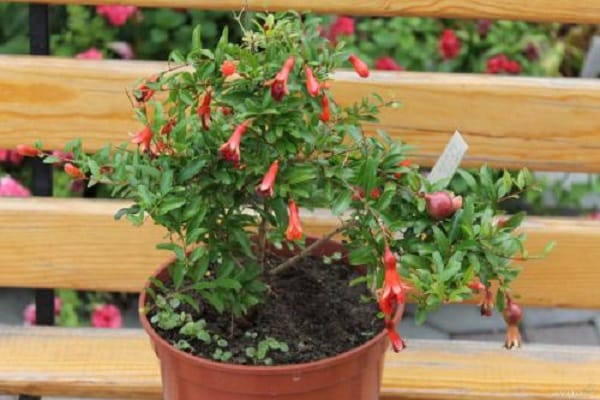
External parameters and characteristics
Pomegranate is unpretentious, but each variety has its own characteristics.The shrub form of the plant is suitable for window sills.
The crown is wide, with numerous erect branches covered with brown bark. The leaves are small, elongated, olive green. The plant is deciduous or evergreen. It all depends on the conditions of detention and care.
There are two types of scarlet flowers - male and female. There are more male ones, they resemble bells. Women are more elongated, small fruits are formed from them. At first they are covered with a thin orange peel. By the time of ripening, the color changes to burgundy with a brown tint.
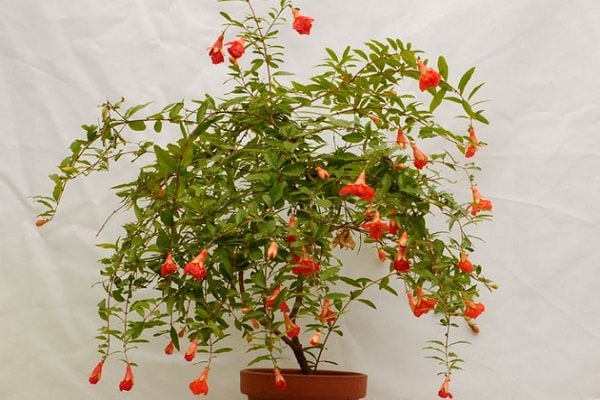
Growing and propagating a house tree
Reproduction and cultivation of indoor pomegranate does not differ from planting other ornamental plants. The seed can be seeds or cuttings. If the goal is to grow an ornamental plant for the sake of beauty, and not fruit, then you can use the seeds of an ordinary ripe pomegranate. To get delicious fruit, you should think about how and how to plant a houseplant.
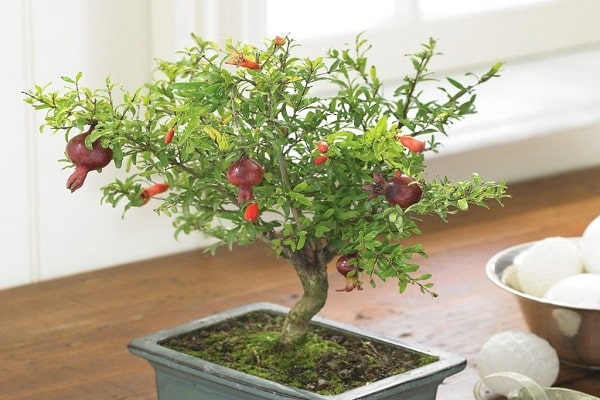
From the cutting
When planting a cutting, all the characteristics of the variety are preserved. The plant blooms earlier and begins to bear fruit. Cuttings are harvested in early July or late winter. In the first case, the cuttings take root better. But the latter are more often used. The mother plant is less at risk of damage.
Cuttings are taken about 10 centimeters long with five or seven buds. The cut is made with a sharp knife at an angle, from fruit-bearing trees. Sections are treated with a root stimulant, planted in fertile soil at an angle. Cover with foil, keep warm, watered regularly.
After a month, the cuttings will take root, young buds will appear. The film is removed. For better branching, a third of the shoot is cut off.

From seeds
You can use store seeds. Better to take the seeds of a ripe indoor pomegranate. They are cleaned of pulp, hard bones are selected. Before sowing, soak in water with a growth stimulator. Seeds should be sown in November or March, in a moistened mixture of peat and sand. Seedlings will appear in 2 weeks.
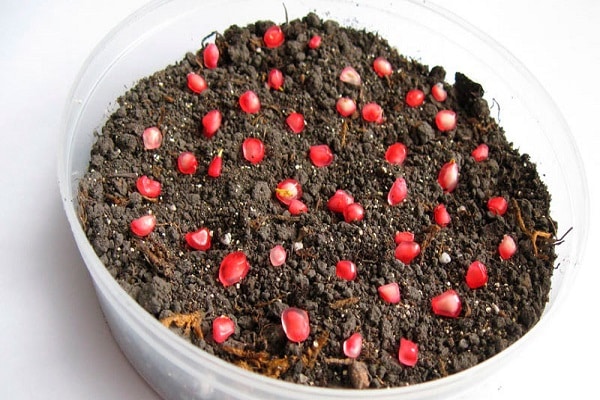
How pomegranate grows
When pomegranates are grown in comfortable conditions, the leaves are preserved all year round. In the absence of such, leaf fall begins. Then it is advisable to rearrange the plant in a cool room until spring, occasionally watering.
In March, the pomegranate wakes up from hibernation. Leaves bloom first, and after a few weeks - flowers. Flowering continues until autumn. In summer, pomegranates are taken out to the balcony or garden, protected from the wind.
Necessary conditions for growth
To know how to grow pomegranates, you need to familiarize yourself with some of the rules for indoor floriculture.
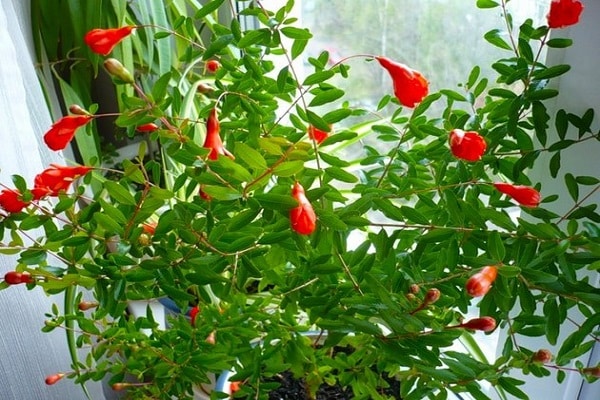
Soil composition
A young plant is suitable for soil consisting of sand, leafy, turfy land, humus. All components are taken in equal parts. For a mature tree, you can prepare a soil from 50% turf, 25% leaf humus, 12% peat, 13% sand.
Suitable pot and its volume
Initially, the roots of the pomegranate should grow in close quarters. When transplanting, the diameter of the pot increases by 2 centimeters.
Lighting
The tree needs a lot of sunlight. It is better to place the pomegranate on the south side of the window. In the summer, at lunchtime, in order to protect the plant from burns, it must be shaded.

Temperature
The pomegranate tree loves warmth. During flowering, the temperature should not exceed twenty-five degrees.
Air humidity
If the room is stuffy, and the air temperature exceeds 25 degrees, the pomegranate is sprayed twice a day with summer, settled water.
Care rules
Not every novice florist knows how to properly care for a plant. It is not difficult to learn this, just a little effort is enough. As a result, a healthy pomegranate tree will grow and bear fruit at home.

Watering and spraying
How often to water the plant? It depends on the time of year.In winter, abundant watering is not needed. More moisture is required in spring. In summer, the plant is often watered, but avoiding stagnant water. In the heat, the tree is sprayed daily with settled water.
Fertilizer
It is necessary to start fertilizing in the spring and continue until the fall. How to feed the plant? Better to give preference to nitrogen-phosphorus and organic fertilizers. No groundbait is required in winter.
Forming and pruning a bush
To make the pomegranate bloom more abundantly, bear more fruit, look well-groomed, pruning is required. This procedure is carried out in early autumn. You need to cut off dried, twisted, densely growing branches.
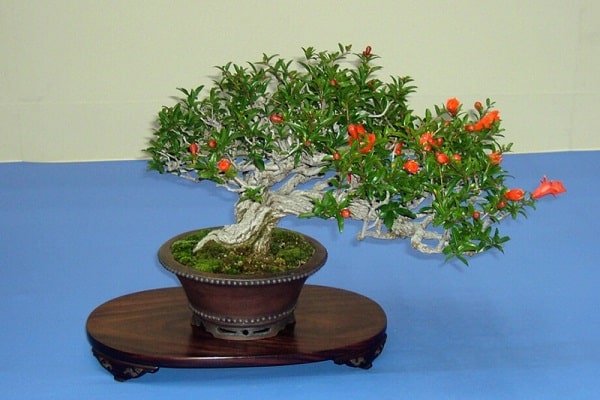
Transfer
Pomegranate up to three years old must be transplanted annually, in early spring. Mature trees - once every three years.
Dormant period
In the fall, the pomegranate tree begins to prepare for wintering, gradually shedding its leaves. At this time, it is necessary to create certain conditions. First, move the plant to a cool room with a temperature of at least 13 degrees. Also reduce watering.
Three-year-old trees must be prepared for wintering. Until this age, young pomegranates can overwinter under normal conditions.
How to plant a pomegranate for fruiting
Without experience, the grafting process may not always be successful. For grafting, you need to take a stalk grown from a seed and a bud from a fruiting tree. On the handle, make a shallow incision in the bark, one and a half centimeters long. Insert the cut kidney into the incision, wrap the graft with electrical tape. Sprinkle the pomegranate generously.
After eight days, it will be clear whether the grafting process was successful or not. After the scion, the pomegranate tree will begin bearing fruit in five years.
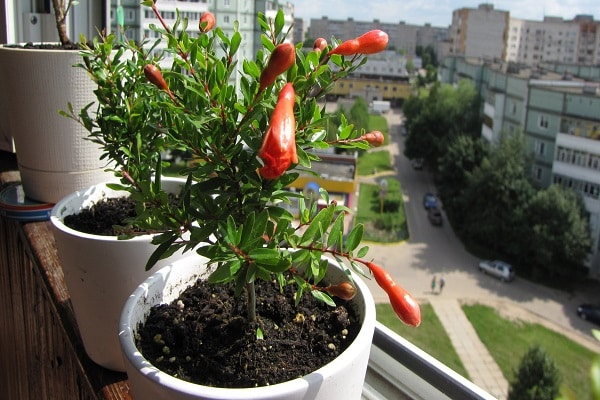
The beginning of flowering and fruiting and features of care during this period
Flowering begins in late April-early May and lasts until the end of August. Flowers have different shapes. In the form of a bell - not bearing fruit, and if they look like a jug - a pomegranate will gradually form from these flowers.
Care should be as follows:
- For greater productivity during flowering, watering is reduced, but the soil should not be allowed to dry out.
- You need to spray the tree carefully, it is unacceptable for drops of water to get on the flowers.
- For a flowering tree, a suitable room temperature is twenty degrees.
- Fertilize once a month with phosphorus fertilizer.
Diseases and characteristic symptoms
There are several diseases that can affect indoor pomegranate.
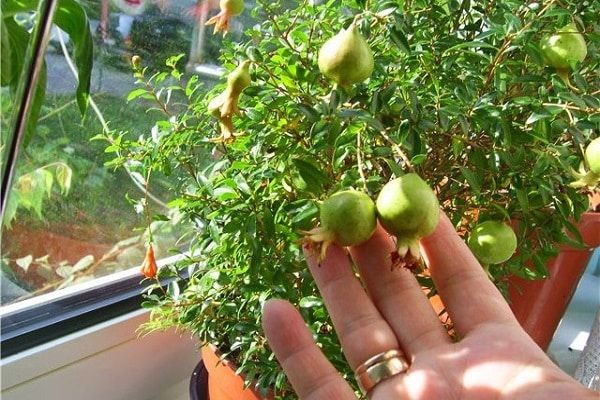
Powdery mildew
Basically, the fungus affects pomegranate in the middle of summer. The infected plant becomes covered with a white bloom, in the early stages of the disease it resembles a cobweb. Over time, the leaves lose their shape, turn yellow, fall off. In case of infection, pomegranates must be treated with Fundazol.
Branch cancer
With a disease, the bark of the pomegranate tree swells, the twigs become covered with cracks. The plant must be cleaned of affected branches, cut off with a sharp knife. It is quite difficult to cure pomegranate from this disease.
But you can prevent its appearance. To do this, it is necessary to observe the temperature regime, to prevent damage and hypothermia of the tree.
Spots on the leaves
Leaves may develop yellowish brown spots due to excess moisture in the soil. If spots appear, the plant must be transplanted, while removing the rotten roots.

Whitefly and aphids
Pests settle on pomegranate leaves, gradually suck out juice from greens, lay larvae. The breeding process is fast enough. The infected tree must be treated with soapy water or karbofos.
What problems arise when growing
Indoor grenade owners can face some problems.
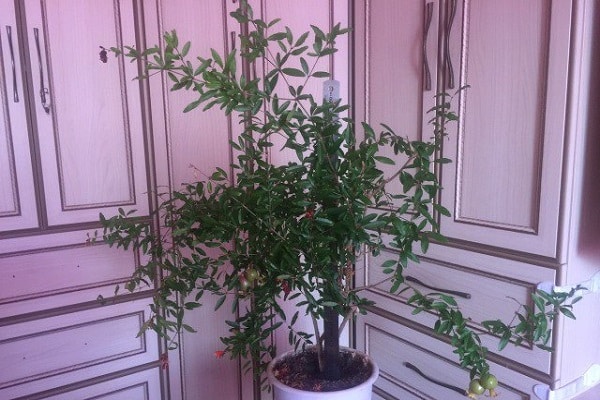
Does not grow
Reasons for poor growth of indoor pomegranate:
- After transplantation, it can grow roots.
- The potting soil is firm.
- Insufficient lighting.
Blooms but does not bear fruit
The plant does not bear fruit for several reasons:
- If the rest period has been violated.
- Not enough warmth.
- Bad light.
- Frequent drying out of the soil or excess moisture.
- Lack of nutrients in the soil. From April to September, it is necessary to apply mineral and organic fertilizers once a month, alternately.
- Not regular crown formation.
- The bell-shaped flower is sterile. It is better to cut such flowers.
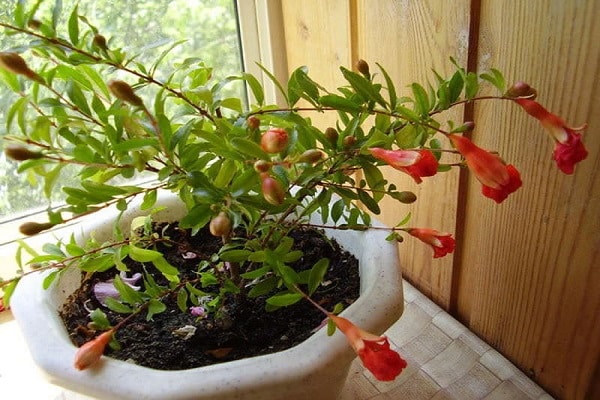
Often sick
Frequent illness may indicate improper care. A disease such as powdery mildew can affect a tree due to low temperature, high humidity, and musty premises.
With frequent watering, stagnant water in the sump, the root system of the plant will begin to rot. Gradually the leaves turn yellow, then crumble. In a short period, the tree dies. To prevent this from happening, the plant must be carefully removed from the pot, the roots that have begun to rot are removed. Wash the root with a solution of potassium permanganate, dry, sprinkle the cut with activated carbon. Transplant into a different soil.
A sickly type of plant in the spring-summer period may indicate a lack of moisture and nutrients in the soil.
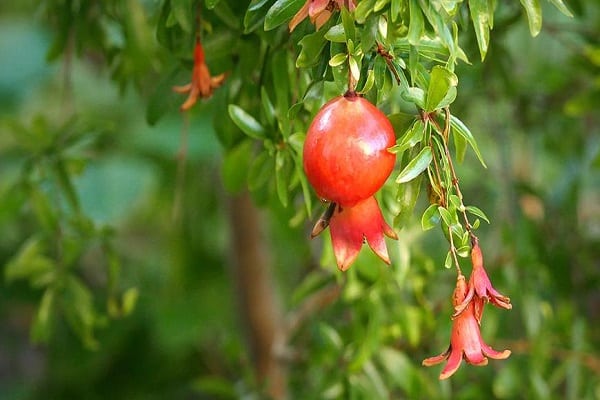
Leaves turn yellow
If at the beginning of autumn the leaves began to turn yellow on the tree, this is not a problem. Pomegranate is a deciduous plant and leaf shedding is a natural process at this time of year.
The plant does not tolerate darkened rooms, dry air, drying out of the soil. The place of growth for the indoor tree must be chosen near the south window. If the pomegranate has been in the shade for a long time, it must be taught to light gradually.
Untimely watering is detrimental to the plant. Especially the soil should be monitored in the summer and heating season, as the soil dries out faster. After watering, the water must be removed from the pallet.
